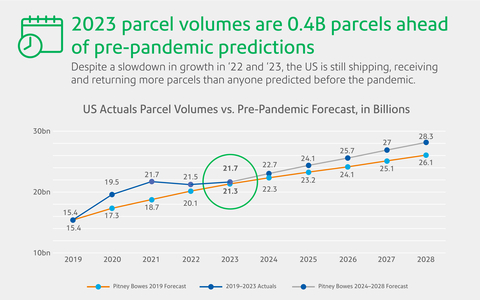Pitney Bowes Parcel Shipping Index: Consumer Demand for “Real-Time Retail” Shakes Carrier Market Share
U.S. Market Parcel Revenue Sees First Decline in Seven Years Despite Increased Parcel Volume
This press release features multimedia. View the full release here: https://www.businesswire.com/news/home/20240417690112/en/

2023
Of the four largest carriers (
Both Amazon Logistics and
“Despite the continued aftershocks of the COVID-19 pandemic, persistent inflation, and pessimistic economic perceptions, consumer spending remains resilient, primarily via a growing demand for affordable goods from global marketplaces. The result is an influx of smaller, less-expensive, lightweight packages which drive up volumes at a lower rate of revenue-per-piece,” said
The four largest carriers shared more of the market with smaller competitors in 2023, as "other” carriers saw their combined volumes grow 28.5%. This was underscored by a 0.5% increase (to 21.7B) in parcel volume alongside the first parcel revenue decline in seven years (0.3% decline to
“The legacy players are still adapting as the delivery landscape shifts to favor natively direct-to-consumer parcel networks that are designed from the start to serve residential deliveries, such as the
Nurmohamed added: “As shippers gain access to an array of carrier options, multi-carrier platforms with recommendation engines help them identify and select the best carriers for their network and individual shipments, meeting customer demands efficiently and cost-effectively. It’s what
Carrier Volume
While
-
The
USPS generated the highest parcel volume, at 6.6 billion parcels and down almost 1% from last year. - This was followed by Amazon Logistics generating 5.9 billion parcels, up 15.7% from the previous year.
-
UPS declined 10.3% from the previous year to 4.6 billion parcels. - FedEx declined 6.1% from 4.1 billion in 2022 to 3.9 billion in 2023.
- The “others” category grew 28.5% in 2023, from 0.5 billion to 0.6 billion parcels.
Market Share by Volume
-
USPS continues to have the largest market share (31%). -
For the first time in the Index’s history, Amazon Logistics became the second provider with the largest market share (27%), surpassing
UPS . -
UPS fell to third place with a 21% market share. - The “others” category increased its share from 2% to almost 3% of the market.
Carrier Revenue
In 2023,
-
UPS generated the highest parcel revenue of the major carriers at$68.9 billion , down 6.4% year-over-year. -
This was followed by FedEx at
$63.2 billion , down 3.1% from last year. -
USPS increased 0.8% to$31.7 billion from$31.4 billion in 2022. -
Amazon Logistics grew 19% to
$28.6 billion from$24 billion in the previous year. It also saw the highest CAGR 2016 – 2023 at 60%. -
The “others” category had the most significant revenue growth of 32.5% in one year, to
$5.6 billion in 2023 from$4.3 billion in 2022.
Market Share by Revenue
-
UPS had the largest parcel revenue market share, with 35% of the market, a 2% decrease from 2022, followed by FedEx, with a 32% share in 2023. -
USPS maintained its revenue market share of 16%. - Amazon Logistics increased by two percentage points to 14%.
- The “others” category increased from 2.1% to 2.8%.
Forecast
-
Pitney Bowes forecasts thatU.S. parcel volume will reach between 23 billion and 35 billion by 2029. - The most likely scenario is that it will reach 29 billion with a 5% CAGR between 2024 and 2029.
About the Pitney Bowes Parcel Shipping Index
The Pitney Bowes Parcel Shipping Index measures parcel volume and spend for business-to-business, business-to-consumer, consumer-to-business, and consumer-consigned shipments that weigh up to 70 pounds (31.5 kg). Parcels are defined as shipments that do not require special handling. The Index provides last-mile view of parcels. Carrier revenue includes the cost to ship an item from its point of origin to point of destination, and margins charged by the carrier. This does not include the price value of the item being shipped.
About
View source version on businesswire.com: https://www.businesswire.com/news/home/20240417690112/en/
Marifer Rodriguez
Director of Communications
marifer.rodriguez@pb.com
Source:
